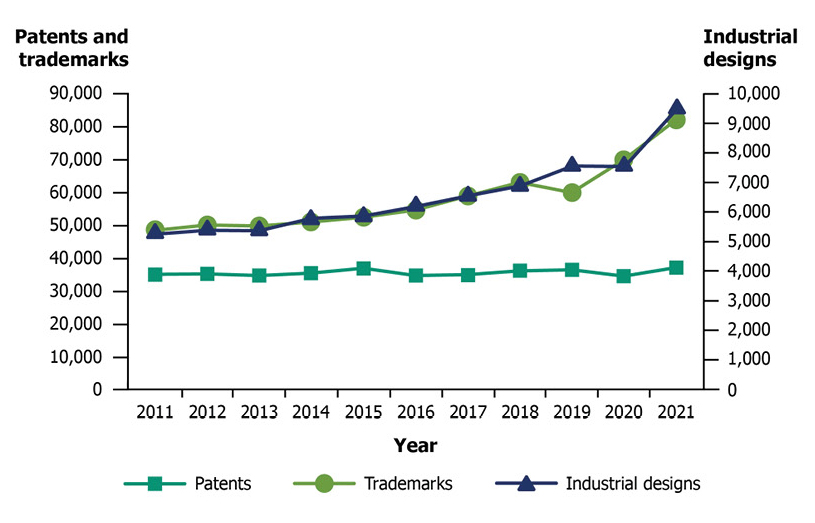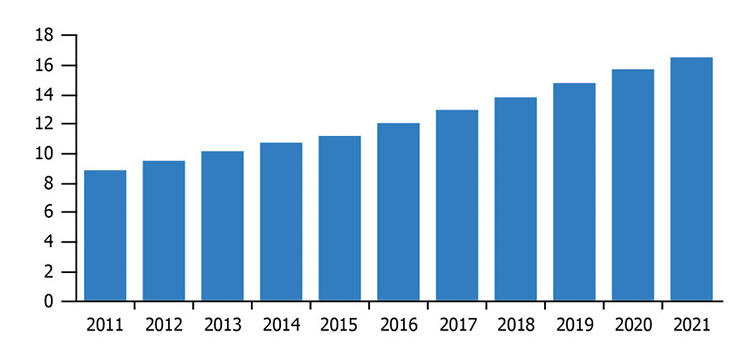On this page
- Rising demand for IP
- Increasing complexity and pace of technological change
- The growing role of IP offices in the IP ecosystem
- Embracing equity, diversity, inclusion and accessibility
- Focus on digital service delivery
Rising demand for IP
Global demand for IP rights is rising, a trend that was undeterred by a global pandemic and is likely to continue as IP takes on greater prominence in the knowledge economy. Over the past decade, Canada has observed steady growth in applications for trademarks, industrial designs and copyrights. Demand for patent protection has remained consistent, with long-term growth in non-resident applications. The rise in demand may be in part fuelled by an increase in awareness of the value of IP, the growing online presence of companies during the pandemic and by an increasingly brand-conscious society. A well-functioning IP office is fast becoming a cornerstone of successful innovation ecosystems and economic growth.

Figure 1 - Text version
| Year | Patents | Trademarks | Industrial designs (right axis) |
|---|---|---|---|
| 2011 | 35,111 | 48,472 | 5,227 |
| 2012 | 35,242 | 50,110 | 5,362 |
| 2013 | 34,741 | 49,819 | 5,346 |
| 2014 | 35,481 | 51,028 | 5,767 |
| 2015 | 36,964 | 52,461 | 5,846 |
| 2016 | 34,745 | 54,665 | 6,170 |
| 2017 | 35,022 | 58,913 | 6,533 |
| 2018 | 36,161 | 63,058 | 6,737 |
| 2019 | 36,488 | 59,961 | 6,390 |
| 2020 | 34,565 | 69,942 | 6,187 |
| 2021 | 37,155 | 82,075 | 7,051 |

The NASA James Webb Space Telescope is the world's premier space science observatory. This is a great example of how technology keeps evolving and that, indeed, the sky knows no limit. Source: Cosmic Cliffs in the Carina Nebula (NIRCam Image), https://webbtelescope.org/news/first-images
Increasing complexity and pace of technological change
At the same time, new technologies are being developed that are increasingly complex due to the changing nature of innovation. Innovation is becoming more global, interconnected and interdisciplinary, and the pace of change is accelerating. The amount of available IP data is growing at a staggering rate. In 2020, 15.9 million patents were in force worldwide along with 64.4 million active trademark registrations and 4.8 million industrial designs. Artificial intelligence (AI) is a technology area that has garnered considerable interest in recent years, as it can now be used to support IP administration. As innovation continues to evolve, new technologies will emerge that will require IP offices to adapt and will challenge the role of the IP system in creating certainty in the marketplace.

Source: WIPO Statistics Database
Figure 2 – text version
| Year | Patents |
|---|---|
| 2011 | 8,937,300 |
| 2012 | 9,590,100 |
| 2013 | 10,245,300 |
| 2014 | 10,827,000 |
| 2015 | 11,399,100 |
| 2016 | 12,178,300 |
| 2017 | 13,082,800 |
| 2018 | 13,948,600 |
| 2019 | 14,928,800 |
| 2020 | 15,873,500 |
| 2021 | 16,545,000 |
The growing role of IP offices in the IP ecosystem
IP offices play a significant role in advancing innovation and economic development. The Government of Canada has recognized the need for an effective IP system and has brought IP to the forefront through the National IP Strategy. We must work with domestic and international stakeholders within the innovation ecosystem to improve the functioning of the IP system and respond to clients' evolving needs. CIPO will support research and innovation in Canada by better understanding IP trends, providing education on the benefits of IP to address gaps in the marketplace and the needs of underrepresented groups and supporting the negotiation and implementation of regulatory, legislative and trade commitments.
Embracing equity, diversity, inclusion and accessibility
There is a call to action in Canada's federal public service on anti-racism, equity and inclusion. Despite having made progress to become a more diverse and inclusive society, major advances must be made to tackle racism and discrimination and remove barriers to inclusion. The message extends not only to increasing representation in our organizations but also to understanding the challenges and obstacles faced by the under-represented groups and communities we serve and taking action to address barriers.
Focus on digital service delivery
Like many offices and organizations, CIPO quickly transitioned the majority of its workforce to remote work due to health and safety concerns surrounding COVID-19. To continue operating, some operational processes requiring a physical presence were retooled using technology, resulting in different ways of organizing work and providing service that will have positive and long-lasting effects. The future of work and service delivery will maximize the use of technology, a shift that will improve service quality, office efficiency, productivity and our environmental footprint.

